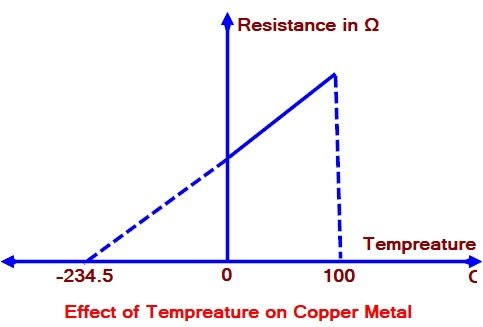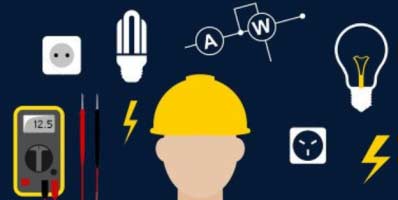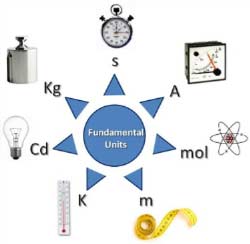161. If a resistor ZR is connected between R and N, ZBR between R and B, ZRY between R and Y, and ZBY between B and Y form a delta connection, then after transformation to star, the impedance at R is?
A. (ZBRZBY)/(ZRY + ZBY + ZBR)
B. (ZRYZBR)/(ZRY + ZBY + ZBR)
C. (ZRYZBY)/(ZRY + ZBY + ZBR)
D. (ZRY)/(ZRY + ZBY + ZBR)
162. If a resistor ZR is connected between R and N, ZBR between R and B, ZRY between R and Y, and ZBY between B and Y form a delta connection, then after transformation to star, the impedance at Y is?
A. (ZRY)/(ZRY + ZBY + ZBR)
B. (ZBY)/(ZRY + ZBY + ZBR)
C. (ZRYZBY)/(ZRY + ZBY + ZBR)
D. (ZRYZBR)/(ZRY + ZBY + ZBR)
163. If a resistor ZR is connected between R and N, ZBR between R and B, ZRY between R and Y, and ZBY between B and Y form a delta connection, then after transformation to star, the impedance at B is?
A. (ZBRZBY)/(ZRY + ZBY + ZBR)
B. (ZRYZBY)/(ZRY + ZBY + ZBR)
C. (ZBY)/(ZRY + ZBY + ZBR)
D. (ZBR)/(ZRY + ZBY + ZBR)
164. If the resistors of a star-connected system are ZR, ZY, and ZB then the impedance ZRY in delta connected system will be?
A. (ZRZY + ZYZB + ZBZR)/ZB
B. (ZRZY + ZYZB + ZBZR)/ZY
C. (ZRZY + ZYZB + ZBZR)/ZR
D. (ZRZY + ZYZB + ZBZR)/(ZR + ZY)
165. If the resistors of a star-connected system are ZR, ZY, ZB then the impedance ZBY in a delta-connected system will be?
A. (ZRZY + ZYZB + ZBZR)/(ZB + ZY)
B. (ZRZY + ZYZB + ZBZR)/ZB
C. (ZRZY + ZYZB + ZBZR)/ZY
D. (ZRZY + ZYZB + ZBZR)/ZR
166. If the resistors of a star-connected system are ZR, ZY, and ZB then the impedance ZBR in delta connected system will be?
A. (ZRZY + ZYZB + ZBZR)/ZY
B. (ZRZY + ZYZB + ZBZR)/R
C. (ZRZY + ZYZB + ZBZR)/ZB
D. (ZRZY + ZYZB + ZBZR)/(ZB + ZR)
167. Asymmetrical three-phase, three-wire 440V supply is connected to star-connected load. The impedances in each branch are ZR = (2 + j3) Ω, ZY = (1 − j2) Ω, ZB = (3 + j4) Ω. Find ZRY.
A. (5.22 − j0.82) Ω
B. ( − 3.02 + j8) Ω
C. (3.8 − j0.38) Ω
D. ( − 5.22 + j0.82) Ω
168. A symmetrical three-phase, three-wire 440V supply is connected to star − connected load. The impedances in each branch are ZR = (2 + j3) Ω, ZY = (1 − j2) Ω, ZB = (3 + j4) Ω. Find ZBY.
A. ( − 5.22 + j0.82) Ω
B. (5.22 − j0.82) Ω
C. (3.8 − j0.38) Ω
D. ( − 3.02 + j8) Ω
169. A symmetrical three-phase, three-wire 440V supply is connected to star − connected load. The impedances in each branch are ZR = (2 + j3) Ω, ZY = (1 − j2) Ω, ZB = (3 + j4) Ω. Find ZBR.
A. (5.22 − j0.82) Ω
B. ( − 3.02 + j8) Ω
C. ( − 5.22 + j0.82) Ω
D. (3.8 − j0.38) Ω
170. If a star-connected system has equal impedances Z1, then after converting into delta connected system having equal impedances Z2, then?
A. Z2 = Z1
B. Z2 = 2Z1
C. Z2 = 3Z1
D. Z2 = 4Z1
171. Find the equivalent delta circuit in Star − Delta Transformation.
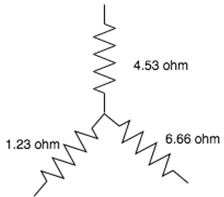
A. 9.69 ohm, 35.71 ohms, 6.59 ohm
B. 10.69 ohm, 35.71 ohms, 6.59 ohm
C. 9.69 ohm, 34.71 ohms, 6.59 ohm
D. 10.69 ohm, 35.71 ohms, 7.59 ohm
172. Which among the following is the correct expression for star-delta conversion?
- R1 = Ra × Rb/(Ra + Rb + RC., R2 = Rb × Rc/(Ra + Rb + RC., R3 = Rc × Ra/(Ra + Rb + RC.B.
- R1 = Ra/(Ra + Rb + RC., R2 = Rb/(Ra + Rb + RC., Rc = /(Ra + Rb + RC.
- R1 = Ra + Rb + Ra × Rb/Rc, R2 = Rc + Rb + Rc × Rb/Ra, R3 = Ra + Rc + Ra × Rc/Rb
- R1 = Ra × Rb/Rc, R2 = Rc × Rb/Ra, R3 = Ra × Rc/Rb
173. Find the equivalent resistance between X and Y using star-delta transformation.
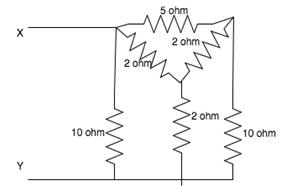
A. 3.33 ohm
B. 4.34 ohm
C. 5.65 ohm
D. 2.38 ohm
174. Delta connection is also known as_________
A. Y − connection
B. Mesh connection
C. Either Y − connection or mesh connection
D. Neither Y − connection nor mesh connection
175. Ra is resistance at A, Rb is resistance at B, and Rc is resistance at C in star connection. After transforming to delta, what is the resistance between B and C?
A. Rc + Rb + Rc × Rb/Ra
B. Rc + Rb + Ra × Rb/Rc
C. Ra + Rb + Ra × Rc/Rb
D. Rc + Rb + Rc × Ra/Rb
176. Ra is resistance at A, Rb is resistance at B, and Rc is resistance at C in star connection. After transforming to delta, what is the resistance between A and C?
A. Ra + Rb + Ra × Rb/Rc
B. Ra + Rc + Ra × Rc/Rb
C. Ra + Rb + Ra × Rc/Ra
D. Ra + Rc + Ra × Rb/Rc
177. Ra is resistance at A, Rb is resistance at B, and Rc is resistance at C in star connection. After transforming to delta, what is the resistance between A and B?
A. Rc + Rb + Ra × Rb/Rc
B. Ra + Rb + Ra × Rc/Rb
C. Ra + Rb + Ra × Rb/Rc
D. Ra + Rc + Ra × Rc/Rb
178. If a 1ohm 2ohm and 32/3ohm resistor is connected in star, find the equivalent delta connection.
A. 34 ohm, 18.67 ohms, 3.19 ohm
B. 33 ohm, 18.67 ohms, 3.19 ohm
C. 33 ohm, 19.67 ohms, 3.19 ohm
D. 34 ohm, 19.67 ohms, 3.19 ohm
179. If an 8/9ohm, 4/3ohm, and 2/3ohm resistor are connected to the star, find its delta equivalent.
A. 4ohm, 3ohm, 2ohm
B. 1ohm, 3ohm, 2ohm
C. 4ohm, 1ohm, 2ohm
D. 4ohm, 3ohm, 1ohm
180. Find the equivalent resistance between A and B using star-delta transformation.
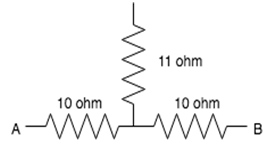
A. 32ohm
B. 31ohm
C. 30ohm
D. 29ohm

